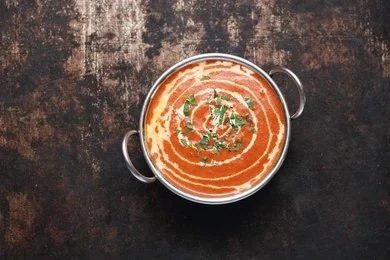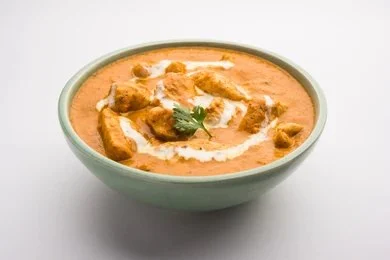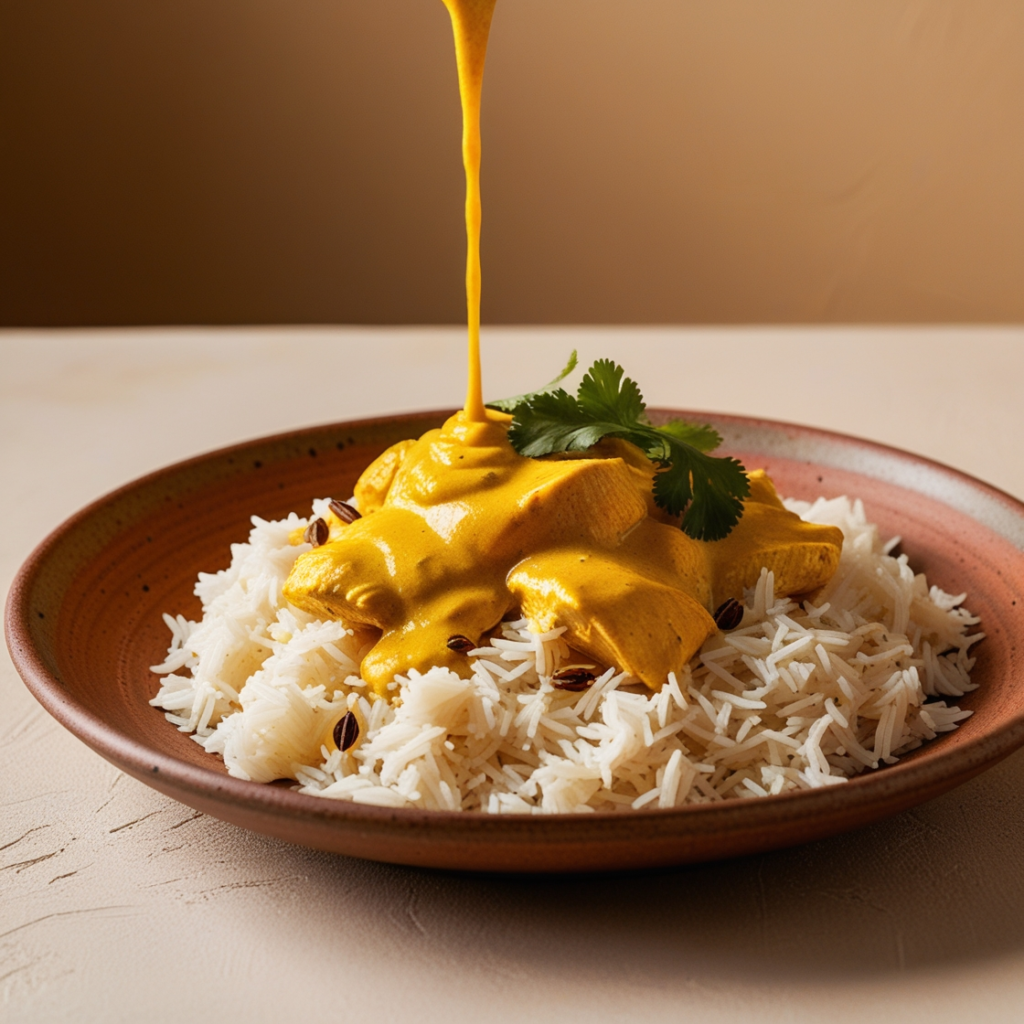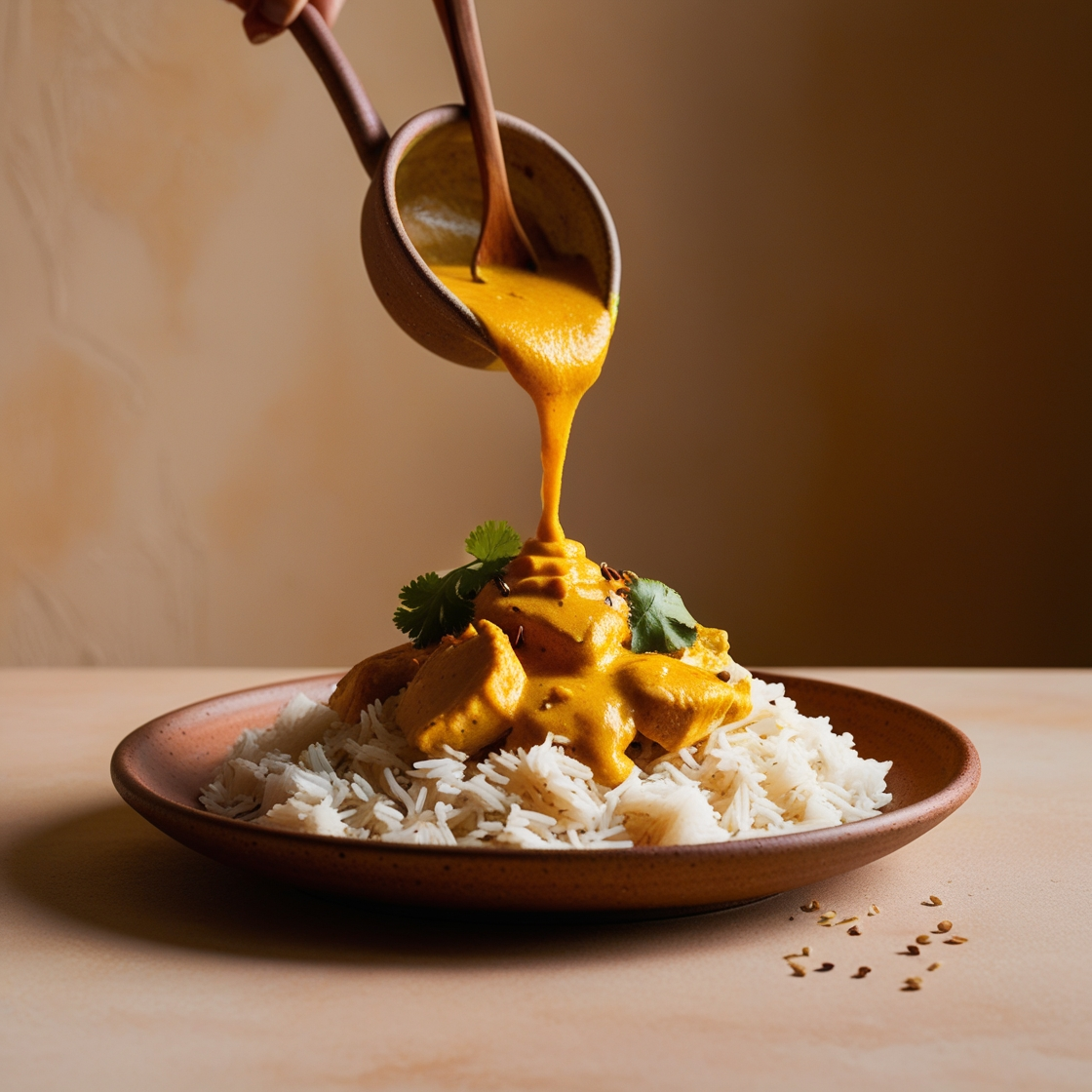Introduction
Butter chicken is a beloved dish known for its rich and creamy sauce that blends savory spices with a smooth texture. It is one of the most popular dishes in Indian cuisine, enjoyed by food enthusiasts worldwide. But what is butter chicken sauce made of? The answer lies in its essential ingredients: butter, cream, tomatoes, aromatics, and a harmonious mix of spices.
This guide thoroughly explores the origins of butter chicken and its sauce, while also breaking down the role of each key ingredient. By gaining a deeper understanding of these essential elements, you can confidently create an authentic version of this classic dish. Furthermore, each section provides valuable insights into the importance of butter, cream, tomatoes, aromatics like onion and garlic, and the essential spices that come together to define its signature flavor..
Origins of Butter Chicken and Its Sauce
Butter chicken, also known as Murgh Makhani, originated in the 1950s at the iconic Moti Mahal restaurant in Delhi, India. This dish was born out of culinary innovation, as chefs looked for a creative way to repurpose leftover tandoori chicken. By simmering the chicken in a rich, buttery tomato-based sauce, they created a dish that quickly became a staple in Indian cuisine and a global favorite.
Key Aspects of the Origins:
- It reflects the rich culinary traditions of North India.
- Butter chicken sauce was designed to balance the bold flavors of spices with the richness of butter and cream.
- Its creation marked the beginning of a dish that would gain global popularity.
The origins of this dish highlight the brilliance of combining simple ingredients like butter, tomatoes, and cream. These components define what butter chicken sauce is made of, creating a recipe that is both flavorful and versatile.

The Role of Butter in Butter Chicken Sauce
Butter is the foundation of this recipe, giving it its name and contributing to its luxurious texture and flavor.
Why Butter Is Essential:
- It acts as a flavor enhancer, bringing out the depth of the spices.
- Creates a silky texture that coats the chicken and other ingredients.
- Balances the acidity of tomatoes, ensuring a rich yet smooth taste.
For the best results, use high-quality unsalted butter to avoid overpowering the sauce with saltiness. The butter should be melted gently to sauté the spices and aromatics, allowing their flavors to infuse deeply into the sauce. This step underscores the importance of butter in answering what is butter chicken sauce made of.
Cream: The Key Ingredient for That Silky Texture
The inclusion of cream in butter chicken sauce is, without question, what makes the dish truly indulgent. Moreover, it transforms the sauce by introducing a velvety smoothness that not only enhances its texture but also perfectly balances the boldness of the spices.
Why Cream Is a Must-Have:
- It provides the sauce with its characteristic silky texture.
- Tames the heat from spices, making the dish appealing to a wide range of palates.
- Adds a layer of richness that complements the tanginess of tomatoes.
Heavy cream is, without a doubt, the preferred choice for creating an authentic butter chicken sauce. To achieve the best results, it is important to add the cream toward the end of the cooking process. This not only prevents curdling but also helps preserve the sauce’s smooth and creamy consistency. Furthermore, this ingredient plays a crucial role in defining what butter chicken sauce is made of, as it significantly elevates the dish from being merely simple to truly sophisticated.
Tomatoes: The Base of the Sauce
Tomatoes are the backbone of butter chicken sauce, providing both structure and flavor. Their natural acidity and sweetness are essential for creating the sauce’s balanced profile.
The Importance of Tomatoes:
- They contribute the vibrant red color of the sauce.
- Serve as the primary source of acidity, balancing the richness of butter and cream.
- Add depth of flavor, especially when cooked down to enhance their natural sweetness.
Fresh tomatoes or canned tomato puree work equally well for this recipe. Ensure they are simmered thoroughly to reduce their raw flavor. Adding a pinch of sugar can further enhance their sweetness, making them an integral part of what butter chicken sauce is made of.
Aromatics: Onion and Garlic
Onion and garlic are essential aromatics in butter chicken sauce, providing a robust foundation for its flavor profile.
Why Onion and Garlic Matter:
- Onions bring a natural sweetness and depth when caramelized.
- Garlic infuses the sauce with a savory aroma that complements the spices.
- Together, they create a base that enhances the complexity of the dish.
Finely chop or puree onions and garlic for a smoother sauce texture. Sauté them in butter until golden brown before adding the tomatoes and spices. This step is crucial for extracting maximum flavor and achieving the authentic taste of what butter chicken sauce is made of.
Spices: The Soul of Butter Chicken Sauce
Spices are what truly define the flavor of this dish. They create a balance of heat, warmth, and aroma, making the dish unforgettable.
Key Spices in Butter Chicken Sauce:
- Garam Masala: Adds warmth and complexity.
- Turmeric: Provides a subtle earthiness and golden hue.
- Cumin: Brings a smoky, nutty flavor.
- Coriander: Adds a hint of citrus freshness.
- Red Chili Powder: Enhances both color and heat.
- Fenugreek Leaves (Kasuri Methi): A unique ingredient that adds a slightly bitter, aromatic flavor.
To unlock the full potential of these spices, toast them in butter before adding the liquid ingredients. This process intensifies their aroma and flavor, ensuring they blend seamlessly into the sauce. These spices are at the heart of what butter chicken sauce is made of, creating a dish that is as flavorful as it is aromatic.s. This step ensures maximum flavor infusion and an aromatic sauce that captivates the senses.
Yogurt or Marinade Influence in the Sauce
One of the key elements in preparing butter chicken is marination. While the chicken itself is marinated, the yogurt-based marinade often influences the flavor of the sauce.
How Yogurt Impacts the Sauce:
- Adds a subtle tanginess that complements the tomato base.
- Helps tenderize the chicken, ensuring it absorbs the flavors of the sauce.
- Contributes to the overall richness when the marinade mixes with the sauce during cooking.
To achieve the best results, use plain, full-fat yogurt in the marinade. The acidic nature of yogurt enhances the spices and creates a smoother sauce consistency. While the yogurt flavor mellows during cooking, it plays a crucial role in answering what is butter chicken sauce made of.

Balancing Sweetness and Acidity
Butter chicken sauce is celebrated for its perfect balance of flavors. Sweetness and acidity play a pivotal role in achieving this harmony.
Key Ingredients for Balance:
- Tomatoes: Provide natural acidity that forms the sauce’s base.
- Cream and Butter: Add sweetness and richness to counterbalance the tartness.
- Sugar or Honey: Often used sparingly to enhance the dish’s sweetness.
A well-balanced sauce skillfully avoids being overly tangy or cloyingly sweet. By thoroughly simmering the tomatoes, their acidity is reduced, which allows their natural sweetness to shine. Additionally, adding a pinch of sugar further rounds out the flavors, creating a harmonious blend. This careful balance not only ensures the sauce remains versatile but also makes it appealing to a wide audience. Moreover, it underscores the importance of each ingredient in defining what is butter chicken sauce made of.
Techniques for Cooking Butter Chicken Sauce
The way you cook it directly impacts its texture, flavor, and aroma. Proper techniques ensure that each ingredient contributes its best to the final dish.
Essential Cooking Techniques:
- Sautéing Aromatics: Onions and garlic should be cooked in butter until golden brown to build a flavorful base.
- Simmering Tomatoes: Allow the tomatoes to cook down until they release their natural sweetness and become a thick paste.
- Tempering Spices: Toasting spices in butter enhances their aromatic properties and flavor.
- Slow Cooking: Let the sauce simmer after adding cream to meld flavors and achieve a velvety texture.
Following these techniques ensures the sauce achieves its signature balance of richness and spice. These steps are essential in creating an authentic version of what is butter chicken sauce made of.
Pairing with Proteins
While chicken is the traditional choice, butter chicken sauce is incredibly versatile and pairs well with other proteins. Its creamy, spiced base complements a variety of options.
Popular Protein Pairings:
- Paneer: A vegetarian alternative that absorbs the sauce’s flavors beautifully.
- Lamb: The richness of lamb pairs perfectly with the creamy sauce.
- Shrimp: Adds a seafood twist to the dish.
- Tofu: A vegan-friendly substitute that works well with the same preparation techniques.
Regardless of the protein, cook it to perfection before incorporating it into the sauce. This method not only allows the protein to absorb the rich flavors of the sauce but also helps it retain its texture. By doing so, you highlight the versatility of what is butter chicken sauce made of and create a dish that is both flavorful and satisfying.
Variations of Butter Chicken Sauce Around the World
It has evolved significantly as it traveled across the globe, with regional adaptations incorporating new flavors and techniques to suit local tastes.
International Variations:
- Western Versions: Often sweeter with less spice, relying more on cream and butter.
- Middle Eastern Influences: Include the addition of dried fruits like raisins for a sweeter profile.
- Thai Fusion: Incorporates coconut milk and lemongrass for a Southeast Asian twist.
- Vegan Adaptations: Use cashew cream or coconut milk to replace dairy while keeping the rich texture.
Each variation retains the essence of what butter chicken sauce is made of while adapting to local palates. These global interpretations highlight the sauce’s universal appeal and versatility.
Frequently Asked Questions About Butter Chicken Sauce
Can It Be Made Vegan?
Yes, you can make butter chicken sauce vegan by making a few thoughtful substitutions. Replace the butter with vegan margarine or neutral oil to keep it rich, and substitute heavy cream with coconut milk or cashew cream for a creamy texture. Swap the chicken with tofu, chickpeas, or vegetables like cauliflower to create a plant-based alternative. Also, check that all spices and ingredients do not contain animal-derived products. While the flavor may change slightly, you can still capture the essence of what defines butter chicken sauce in a vegan version.
Is Butter Chicken Sauce Healthy?
is indulgent and rich, but its healthiness depends on how it is prepared. Traditional recipes contain butter and cream, which are high in calories and fat. To make it healthier, you can:
- Use less butter or replace it with a smaller amount of oil.
- Swap heavy cream for yogurt or light cream.
- Add more vegetables or lean protein.
While it may not be a low-calorie dish, and can be part of a balanced diet when enjoyed in moderation.
How Long Does Butter Chicken Sauce Last?
Can be stored in the refrigerator for up to 3-4 days when kept in an airtight container. To maintain its freshness:
- Allow the sauce to cool completely before refrigerating.
- Reheat gently on the stove or in the microwave, stirring occasionally to prevent separation.
If properly stored, the flavors often deepen, making it even more delicious the next day.
Can You Freeze Butter Chicken Sauce?
Yes, it freezes exceptionally well. To freeze:
- Let the sauce cool completely.
- Transfer it to a freezer-safe container or zip-lock bag, leaving some space for expansion.
- Freeze for up to 3 months.
When ready to use, thaw it overnight in the refrigerator and reheat on low heat. If the sauce separates, stirring in a bit of fresh cream can restore its consistency.
What Are the Best Sides for Butter Chicken?
Butter chicken pairs beautifully with a variety of sides, as they complement its rich and creamy flavor while adding balance to the meal. Popular options include:
- Naan or other Indian breads like roti or paratha.
- Basmati Rice, plain or lightly spiced with cumin.
- Raita, a cooling yogurt-based side dish.
- Salads, such as cucumber or onion salad, for freshness.
- Roasted Vegetables, which add a healthy and crunchy element.
These sides not only complement the dish but also enhance the overall dining experience by balancing the richness of the sauce with contrasting textures and flavors.
Can I Use Butter Chicken Sauce for Other Dishes?
Absolutely! is versatile and can be used in various dishes. Some ideas include:
- Pairing it with proteins like paneer, tofu, lamb, or shrimp.
- Using it as a base for a creamy vegetable curry.
- Tossing it with pasta for a fusion twist.
- Pouring it over baked potatoes or roasted vegetables.
This flexibility allows creative cooks to make it a staple in their kitchens while they retain its core identity as what butter chicken sauce is made of.

Conclusion: Why Butter Chicken Sauce Is a Global Favorite
Butter chicken sauce appeals not only through its perfect balance of creaminess, spice, and tanginess but also because of its remarkable versatility. It pairs effortlessly with a variety of proteins, such as chicken, paneer, or even tofu, and adapts easily to different dietary preferences. Furthermore, the harmonious blend of butter, cream, tomatoes, and spices creates a rich flavor profile that clearly explains why people across the globe cherish it.
By exploring what is butter chicken sauce made of, you can fully appreciate the artistry behind this iconic dish. Whether you enjoy it in its traditional form with tender tandoori chicken or adapt it creatively to suit modern tastes, it continues to shine as a culinary treasure. Moreover, its ability to transcend cultural and geographical borders firmly establishes its place as a global favorite.
Whether you’re exploring new recipes or analyzing classic dishes, the art of crafting this sauce showcases the creativity and depth of Indian cuisine. For a dive into similar culinary histories and formats, see the [ultimate guide to crafting recipes and culinary traditions]

